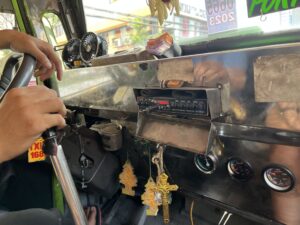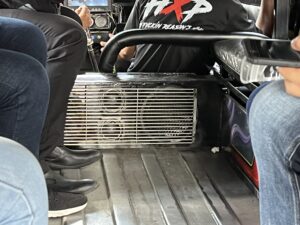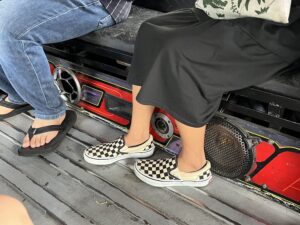The Soundscape of Manila’s Jeepneys
Repurposed or DIY sound technologies can be part of wider techno cultural assemblages that flourish in the urban space without having that of playing recorded music as their original purpose. This is the case of the jeepneys, an affordable transport system in Manila, that sometimes incorporate powerful custom-built sound systems for the pleasure of both the passengers and the owners. Augusto Ledesma introduces us to the world of Philippines’ jeepneys and patók jeep.
by Augusto Ledesma
I have spent around half a year away from Manila, and I am starting to feel as though time moved much slower in the city where I grew up and spent most of my life. Appointments always seemed to account for the improbability of circumventing points of congestion. Things never really started on time; events would generally allow an allowance of around half an hour for everyone to arrive. The city itself was the cause of these disruptions. Options for getting around Manila are quite limited. Queues to get on the metro and light rail systems are incredibly long, often extending beyond the entrances and exits of each station. Buses are difficult to come by and operate on unpredictable schedules. Taxis and motorised tricycles are way too costly for an everyday commute. The roads are not too friendly to cyclists or to pedestrians. The most reliable method of getting around would be to get on a jeepney, a public utility vehicle that services numerous areas in the city and traverses flexible routes while offering affordable fares.

A jeepney parked along the street with airbrushed renderings of the Santo Niño and other religious iconography. © Gerome Soriano
The jeepney has been an essential part of public transportation in Manila for decades, and its design embodies a complex history. Jeepneys are constructed from the parts of US military jeeps that were left behind by American troops in the Philippines after World War II. One would typically find them emblazoned with names and slogans in various fonts, painted with bright colours and adorned with the faces of cartoon characters, iconic actors, or popular musicians alongside airbrushed renderings of religious figures or images of the driver’s family. Its side windows are normally open to the road, and its single point of entry and exit in the rear generally has no doors. Seats face each other, and there are no partitions between passengers. Payments are usually handed over to the driver from a distance, passing the hands of multiple passengers until it reaches the front, operating on a system of honesty and an established social rhythm.

A modified radio unit operated by the driver with a thumb drive containing a collection of mp3 files dangling from the designated slot. © Neo Maestro
One could write volumes on the jeepney as a folk art object and consider its design elements in detail to speculate on the forms of community engendered by the temporary containment of moving bodies in this space, but if I had to assign a single word to describe the jeepney, it would be open. This attitude of openness appears to be the foundation upon which the jeepney is built. The ability to manufacture something novel through improvisation and using only what is available—even if they are scrap metal and spare parts—is a testament to the resourcefulness and innovation of the people that build these vehicles. The jeepney is a product of the labour of various interdependent networks. Artisans, engineers, tradespeople, and operators all come together to collaborate to design and animate the jeepney, suffusing it with a barrage of signs that gesture toward different aspects of Philippine culture [1].
I started relying on the jeepney regularly when I was an undergraduate student at the University of the Philippines. I lived around five minutes away from an informal jeepney garage stationed under an overpass that led to the university. Mornings would regularly consist of waiting in a queue, paying the 8-peso (0.12p) fare to the barker [2], and finding a seat in a cramped space before making the trip to college. I would typically take the same route back home, but I’d usually find myself retreating into my headphones to pass the time while on my commute, shielding myself from the noise of the busy thoroughfare, compounded by the roaring engine and odd sounds of the jeep. A number of jeeps on this route had modified car horns that simulated exaggerated laughter or ridiculous B-movie sound effects. These were noises I wanted to block out, isolating myself from what I used to understand as the ‘external world’ by turning up the volume on my mp3 player. At the time, I was not aware of the fact that I was blocking out a rich auditory environment that was teeming with countless signs of life.

A speaker blaring pop music, installed behind the driver’s seat. © Neo Maestro
One afternoon, I was diverted from my usual route, and I happened to find myself on a patók jeep [3], a jeepney equipped with a high powered sound system and customised with all sorts of eye-catching ornaments both inside and out. I could feel thumping kick drums and hear warped basslines even before entering the jeep, which was a clear enough symbol that putting on headphones to insulate myself from these sounds would be a futile endeavour. I found an empty space right next to the speaker cabinet, which was blaring an assortment of remixes of American nu-metal songs by bands like Linkin Park and System of a Down interspersed with iconic numbers from Filipino alternative rock groups like Eraserheads and Rivermaya [4]. The speaker cabinet had an ostensibly makeshift quality about it and appeared to be hastily assembled from heterogenous components. My eyes darted around the vehicle as I attempted to make sense of the sound system. The jeep had a stereo unit with exposed wires beside the steering wheel with a flash drive—presumably containing a collection of mp3 files—precariously dangling from the dedicated slot. A series of tangled cables run along the panels of the jeepney’s ceiling with their ends tucked away behind the booming speaker. With my headphones stored in my backpack, I felt as though I had immersed myself in a world of sound. What I started to imagine as the soundtrack of my commute was punctuated by the distant voices of ambulant vendors, modulated by an assemblage of noises from innumerable sources, all held in place the clamour of the jeepney cutting through the traffic. I thought I was letting the outside in until I started to think that I had folded myself into the environment, becoming part of everything else.

Speakers lining the passenger benches. © Neo Maestro
I believe that this anecdote is by no means unique; I suspect that scores of people from the Philippines will be able to relay similar encounters with similar ideas and affects drawn from everyday occurrences while commuting. The openness of the jeepney invites these coincidental ruptures. I do feel the need to emphasise, however, that I feel chance encounters with sound have a way of amplifying ordinary experiences. Attempting to recover this moment from the haze of memory was made a lot easier by conscientiously remembering the effect the episode had on my body and how this experience registered on a physical level. This effect was produced by a series of connections that directed disparate flows from one source to another. While this may sound like this process plays out on an abstract level, the same set of exchanges occurs on a literal level as well. The jeepney sound system is a temporary concentration of these discrete elements, momentarily localising several forms of cultural activity within its structure. These mobile sound systems rely on circuits meeting nodes just as much as they depend on intersecting networks of people.
Most drivers will make it a point to customise their jeepneys, adding a personal touch to differentiate their jeeps from the rest of the fleet. Nearly all jeepneys will have custom paint jobs or a collection of trinkets and stickers on the dashboard, and a number of drivers elect to have sound systems added on to their jeeps. These ad hoc sound systems must be installed manually; there are no stock speakers or radio units on board jeepneys when they are purchased, and they gradually accrue all sorts of add-ons over time. Since the interior of the jeepney is not intended to accommodate these modifications, sound systems must adapt to the limited space. Most jeepney sound systems will consist of an equaliser, usually found around the driver’s seat, an amplifier positioned behind the driving booth, and speakers in the middle of the jeep. Some jeeps make use of secondhand radio units lifted from cars. Some drivers plug in mp3 players or phones directly into the equaliser unit. Despite meagre earnings, jeepney drivers that take pleasure in listening to music set aside a few thousand pesos to purchase parts from small audio shops in places like Quiapo—downtown Manila—and have their systems installed or modified by local electricians. There is a sense of community fostered by this environment, one that democratises the processes of building and listening. [5]
This iteration of the jeepney is enmeshed in a protracted struggle against its disappearance. In 2017, the Land Transportation Franchising and Regulatory Board (LTFRB) announced the Public Utility Vehicle Modernisation Program, which would effectively rid the streets of what are now referred to as ‘traditional’ jeepneys. The LTFRB deems the majority of jeepneys to be unsafe and unsustainable and intends to replace vehicles that are fifteen years old or older with newer models that run on Euro 4-compliant internal combustion engines or electric powertrains. This phaseout of the jeepney demands that operators form or join cooperatives or corporations by the end of 2023 to ease the transition and purchase newer models. The Philippine government will provide a 160,000-peso (£2,400) subsidy for this transition, but ‘modern’ jeepneys could cost as much as P2.8 million (£42,000), well beyond the yearly earnings of the typical transport worker (estimated to fall somewhere between P100,000-120,000 or £1500-1800) and significantly more expensive than the traditional jeepney unit (P200,000 or £3,000) [6].

A jeepney with mood lighting, cutting through Manila traffic at night. © Gerome Soriano
The Piston Land Transport Coalition claims that this phaseout is ‘anti-poor’ and far from a just transition as it places the onus of replacing traditional jeepneys on drivers and operators. Body calling it a ‘false solution’ and claiming that ‘the PUV phase-out and modernization program merely exposes the Philippine economy’s fundamental weakness in developing its own industry, creating decent work, protecting the jobs and livelihood of its people, and addressing the climate crisis’ [8]. Transport groups have been organising strikes since 2017, urging the Philippine national government to review the program. A week-long transport strike (from 6-12 March 2023) was about to go ahead in light of a recent announcement that jeepney operators would no longer be able to ply their routes if they failed to join a cooperative by the end of 2023. The threat of extended demonstrations urged the Philippine government to suspend the deadline and review the modernisation program by holding thorough consultations with affected parties.
I was preparing to write a eulogy for the jeepney, but it seems this gesture would have been premature and would tend toward romanticising the struggle of the jeepney drivers and the plight of commuters in Manila. Although it remains to be seen if the national government will hold true to its word (given its adherence to neoliberal drives toward standardisation and erasure), the strike appears to be a crucial moment in the history of protest in the Philippines, a moment of resistance that proves that collective action works. This collectivity is cultivated by the open-ended structure of the jeepney and its component parts, a collectivity that expresses itself in full volume.
—
Augusto Ledesma does research on sound, material culture, and ecological thinking. His work in these areas has taken on various forms including installation, performance, and text, which have appeared in institutional and non-institutional spaces and platforms. He is currently pursuing an MA in Cultural Studies at Goldsmiths and is a member of the Department of English and Comparative Literature at the University of the Philippines.
Notes:
[1] Jeepneys are characterised by maximalist aesthetics. Although there are no standardised designs, one would typically find them painted in lurid colours and with ornate interiors and exteriors. Examples include homemade weaves hewn from offcuts of fabric or neon green plastic bottles placed over radio antennae to catch light. See Nofuente’s ‘The Jeepney: Vehicle as Art’ (1983)
[2] Barkers are stationed at jeepney terminals to call passengers to board the vehicle, make sure all seats are occupied, and collect the fare. The system is modular and contingent on location. There are some jeepneys that have conductors who sit beside the driver and collect fares.
[3] The word ‘patók’ loosely translates to ‘popular’ and refers to jeepneys that are particularly fast, visually arresting, and incredibly loud due to modifications. See Pascua’s ‘The Patók Jeep: A Descriptive Study’ (2009).
[4] Jeepney drivers decide what to play when plying their routes. Playlists often include melodramatic Filipino or American power ballads from the 80s, local hip-hop artists, or a fairly recent strain of Philippine electronic dance music called budots, which has properties of techno and occasionally draws inspiration from meme culture and street dance. See Celera’s ‘The Origins of Budots’ (2019) for an attempt at a genealogy of the genre and Zinampan’s ‘Yes to Dance, No to Drugs’ (2020) for a thorough dissection of its modes of circulation and its political energetics.
[5] Affordable electronics shops have branched out and service various districts. Electricians and engineers will usually assemble components as they are purchased. See Cabral’s ‘The jeepney as a symbol of Filipino musical culture’ (2017).
[6] For a more detailed description and breakdown of events, see Relativo’s ‘Jeepney strike…’ (2023) and ‘Piston slams June 30 phaseout order…’, Rivas’s ‘IN NUMBERS…’ (2023), and Ratcliffe’s ‘Schools and firms across Philippines shut…’ (2023).
Bibliography:
Cabral, A. (2017, July 17). The jeepney as a symbol of Filipino musical culture. CNN Philippines. https://www.cnnphilippines.com/life/culture/tech/2016/11/18/jeepney-sound-systems.html
Celera, L. (2019, September 10). The Origins of Budots, the Philippines’ Catchiest Viral Dance Craze. VICE. https://www.vice.com/en/article/xwewa3/the-origins-of-budots-the-philippines-catchiest-viral-dance-craze
Nofuente, V. (1983). The Jeepney: Vehicle as Art. International Popular Culture, 1 (1), 38-47.
Pascua, F. (2009). The Patók Jeep: A Descriptive Study. Asian Studies, 1 & 2 (15), 83-92.
Ratcliffe, R. (2023, March 6). Schools and firms across Philippines shut as jeepney drivers start strike. https://www.theguardian.com/world/2023/mar/06/schools-and-firms-across-philippines-shut-as-jeepney-drivers-start-strike
Relativo, J. (2023, February 23). Piston slams June 30 jeepney phaseout order, says minibuses worth P2.8-M burying operators in debt. Philippine Star. https://www.philstar.com/headlines/2023/02/23/2247099/piston-slams-june-30-jeepney-phaseout-order-says-minibuses-worth-p28-m-burying-operators-debt
Relativo, J. (2023, March 8). Jeepney strike ends as gov’t agrees to review modernization program. Philippine Star. https://www.philstar.com/headlines/2023/03/08/2250172/jeepney-strike-ends-govt-agrees-review-modernization-program
Rivas, R. (2023, March 6). IN NUMBERS: Why jeepney phaseout is anti-poor, will do little for environment. Rappler. https://www.rappler.com/business/numbers-why-government-phaseout-jeepneys-anti-poor-do-little-environment/
Zinampan, D. (2020). Yes to Dance, No to Drugs: Budots, Imperial Manila, and Mañanitas. Nusasonic. https://www.goethe.de/prj/nus/en/mag/ddb.html
